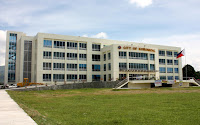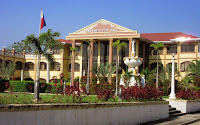Iligan City, is a 1st class highly urbanized city in Northern Mindanao, Philippines. According to the 2015 census, it has a population of 342,618 people.
It is geographically within the province of Lanao del Norte but administered independently from the province. It was once part of Central Mindanao (Region 12) until the province was moved under Northern Mindanao (Region 10) in 2001.
Iligan has a total land area of 813.37 square kilometres (314.04 sq mi), making it one of the 10 largest cities in the Philippines in terms of land area. It had a population of 342,618 inhabitants in the 2015 census.
The name Iligan is from the Higaunon (Lumad/Native of Iligan) word "Ilig" which means "to go downstream".
In the accounts of Jesuit historian Francisco Combes, the Mollucan Sultan of Ternate invaded Panglao. This caused the Dapitans to flee in large numbers to a re-established Dapitan, Zamboanga del Norte.
In Dapitan, the surviving Datu of Panglao Pagbuaya, received Legazpi's expedition in 1595. Later, Pagbuaya's son Manook was baptized Pedro Manuel Manook. Sometime afterwards in by the end of the 16th century after 1595 Manook subdued the higaunon (animist) village of Bayug and turned it into one of the earliest Christian settlements in the country. The settlement survived other raids from other enemies, especially Muslims of Lanao, and the early Iliganons moved their settlement from Bayug to Iligan, which the Augustinian Recollects founded as a mission in 1609.
In 1850, because of floods, Don Remigio Cabili, then Iligan's governadorcillo, built another fort and moved the poblacion of the old Iligan located at the mouth of Tubod River west of the old market to its present site.
Camp Overton in 1900, an American Armybase, currently the location of Global Steel Philippines Inc.
Iligan was already a town of the once undivided Misamis Province in 1832. However, it did not have an independent religious administration because it was part of Cagayan de Oro, the provincial capital. It was one of the biggest municipalities of Misamis Province.
The Spaniards abandoned Iligan in 1899, paving the way for the landing of the American forces in 1900.
In 1914, under the restructuring of Moroland after the end of the Moro Province (1903–1913), Iligan became a municipality composed of eight barrios together with the municipal district of Mandulog. After enjoying peace and prosperity for about 40 years, Iligan was invaded by Japanese forces in 1942.
The liberation in Iligan by the Philippine Commonwealth forces attacked by the Japanese held sway in the city until 1944 to 1945 when the war ended. On November 15, 1944, the city held a Commonwealth Day parade to celebrate the end of Japanese atrocities and occupation.
Lone district
Republic Act No. 9724, an Act separating the City of Iligan from the First Legislative District of the Province of Lanao del Norte was approved by President Gloria Macapagal Arroyo on October 20, 2009.
To the west, Iligan Bay provides ferry and container ship transportation. East of the city, flat cultivated coastal land gives way to steep volcanic hills and mountains providing the waterfalls and cold springs for which the area is well known.
Some Tagalogs, other cultural minorities and immigrants from other places also inhabit Iligan. It is not only rich in natural resources and industries but it is also the home of a mix of cultures: the Maranaos of Lanao, the Higaonon of Bukidnon, and many settlers and migrants from other parts of the country. It is known for its diverse culture.
Language
Cebuano is the major language in the city (92.27%). The rest speak Maranao, Tagalog, Hiligaynon, Ilocano, Chavacano, and Waray-Waray. The majority of the population can speak and understand English.
After the construction of Maria Cristina (Agus VI) Hydroelectric Plant by National Power Corporation (NPC, NAPOCOR) in 1950, the city experienced rapid industrialization and continued until the late 1980s. The largest steel plant in the country, National Steel Corporation (NSC), was also established in 1962.
During the 1997 Asian Financial Crisis, the city experienced severe economic slowdown. A number of industrial plants were closed, notably the National Steel Corporation.
The city made its economic revival with the reopening of the National Steel Corporation, renamed Global Steelworks Infrastructures, Inc. (GSII) in 2004.[18] On October 2005, GSII officially took a new corporate name: Global Steel Philippines (SPV-AMC), Inc.
It is geographically within the province of Lanao del Norte but administered independently from the province. It was once part of Central Mindanao (Region 12) until the province was moved under Northern Mindanao (Region 10) in 2001.
Iligan has a total land area of 813.37 square kilometres (314.04 sq mi), making it one of the 10 largest cities in the Philippines in terms of land area. It had a population of 342,618 inhabitants in the 2015 census.
The name Iligan is from the Higaunon (Lumad/Native of Iligan) word "Ilig" which means "to go downstream".
History
ligan City had its beginnings in the village of Bayug, four (4) kilometers north of the present Poblacion. It was the earliest pre-Spanish settlement of native sea dwellers. In the later part of the 16th century, the inhabitants were subdued by the Visayan migrants from the island-nation called the Kedatuan of Dapitan, on Panglao island.In the accounts of Jesuit historian Francisco Combes, the Mollucan Sultan of Ternate invaded Panglao. This caused the Dapitans to flee in large numbers to a re-established Dapitan, Zamboanga del Norte.
In Dapitan, the surviving Datu of Panglao Pagbuaya, received Legazpi's expedition in 1595. Later, Pagbuaya's son Manook was baptized Pedro Manuel Manook. Sometime afterwards in by the end of the 16th century after 1595 Manook subdued the higaunon (animist) village of Bayug and turned it into one of the earliest Christian settlements in the country. The settlement survived other raids from other enemies, especially Muslims of Lanao, and the early Iliganons moved their settlement from Bayug to Iligan, which the Augustinian Recollects founded as a mission in 1609.
Spanish era
The Jesuits replaced the Recollects in 1639. Iligan was the Spaniards' base of operations in attempting to conquer and Christianize the Lanao area throughout its history. A stone fort called Fort St. Francis Xavier was built in 1642 where Iliganons sought refuge during raids by bandits. But the fort sank due to floods. Another fort was built and this was named Fort Victoria or Cota de Iligan.In 1850, because of floods, Don Remigio Cabili, then Iligan's governadorcillo, built another fort and moved the poblacion of the old Iligan located at the mouth of Tubod River west of the old market to its present site.
Camp Overton in 1900, an American Armybase, currently the location of Global Steel Philippines Inc.
Iligan was already a town of the once undivided Misamis Province in 1832. However, it did not have an independent religious administration because it was part of Cagayan de Oro, the provincial capital. It was one of the biggest municipalities of Misamis Province.
The Spaniards abandoned Iligan in 1899, paving the way for the landing of the American forces in 1900.
American era
In 1903, the Moro Province was created. Iligan, because of its Moro residents, was taken away from the Misamis Province. Then Iligan became the capital of the Lanao District and seat of the government where the American officials lived and held office. Later in 1907 the capital of the Lanao District was transferred to Dansalan.In 1914, under the restructuring of Moroland after the end of the Moro Province (1903–1913), Iligan became a municipality composed of eight barrios together with the municipal district of Mandulog. After enjoying peace and prosperity for about 40 years, Iligan was invaded by Japanese forces in 1942.
The liberation in Iligan by the Philippine Commonwealth forces attacked by the Japanese held sway in the city until 1944 to 1945 when the war ended. On November 15, 1944, the city held a Commonwealth Day parade to celebrate the end of Japanese atrocities and occupation.
Cityhood
Using the same territorial definition as a municipality, Iligan became a chartered city of Lanao del Norte on June 16, 1950. It was declared a first class city in 1969 and was reclassified as First Class City "A" on July 1, 1977 by virtue of Presidential Decree No. 465. In 1983, Iligan was again reclassified as a highly urbanized city.Lone district
Republic Act No. 9724, an Act separating the City of Iligan from the First Legislative District of the Province of Lanao del Norte was approved by President Gloria Macapagal Arroyo on October 20, 2009.
Geography
Iligan City is bounded on the north by the 3 municipalities of Misamis Oriental (namely Lugait, Manticao and Opol), to the south by the 3 municipalities of Lanao del Norte (Baloi, Linamon and Tagoloan) and the 2 municipalities of Lanao del Sur (Kapai and Tagoloan II), to the north-east by Cagayan de Oro City, to the east by the municipality of Talakag, Bukidnon; and to the west by Iligan Bay.To the west, Iligan Bay provides ferry and container ship transportation. East of the city, flat cultivated coastal land gives way to steep volcanic hills and mountains providing the waterfalls and cold springs for which the area is well known.
Demographics
Iligan is predominantly Christian (93.61%). Iliganons are composed of a Cebuano-speaking majority and local minorities mainly Maranaos and Higaonons.Some Tagalogs, other cultural minorities and immigrants from other places also inhabit Iligan. It is not only rich in natural resources and industries but it is also the home of a mix of cultures: the Maranaos of Lanao, the Higaonon of Bukidnon, and many settlers and migrants from other parts of the country. It is known for its diverse culture.
Language
Cebuano is the major language in the city (92.27%). The rest speak Maranao, Tagalog, Hiligaynon, Ilocano, Chavacano, and Waray-Waray. The majority of the population can speak and understand English.
Economy
Iligan is known as the Industrial Center of the South and its economy is largely based on heavy industries. It produces hydroelectric power for the Mindanao region through the National Power Corporation (NAPOCOR), the site of the Mindanao Regional Center (MRC) housing Agus IV, VI and VII hydroelectric plants. It also houses industries like steel, tinplate, cement and flour mills.After the construction of Maria Cristina (Agus VI) Hydroelectric Plant by National Power Corporation (NPC, NAPOCOR) in 1950, the city experienced rapid industrialization and continued until the late 1980s. The largest steel plant in the country, National Steel Corporation (NSC), was also established in 1962.
During the 1997 Asian Financial Crisis, the city experienced severe economic slowdown. A number of industrial plants were closed, notably the National Steel Corporation.
The city made its economic revival with the reopening of the National Steel Corporation, renamed Global Steelworks Infrastructures, Inc. (GSII) in 2004.[18] On October 2005, GSII officially took a new corporate name: Global Steel Philippines (SPV-AMC), Inc.















































































































































